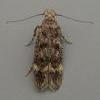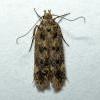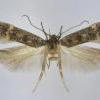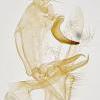35.045 Bryotropha basaltinella (Zeller, 1839)
Status and Distribution
Very local in southern and eastern England, occuring regularly at only a few favoured sites. Elsewhere there are a small number of records from widely scattered parts of northern England. All records from south-west England (Cornwall and Devon) and one or two from the Thames basin, east of London, have been found to be attributable to Bryotropha dryadella, a very similar species.
A significant increase in the number of records received in the 21st century from its main southern English stronghold (c170 since 1999 compared to only c40 prior to that date) suggest the species may be doing well and perhaps expanding its range. It has recently (in 2016) been confirmed in Warwickshire.
A single Scottish record, from Fife, has subsequently been found to refer to another Bryotropha species.
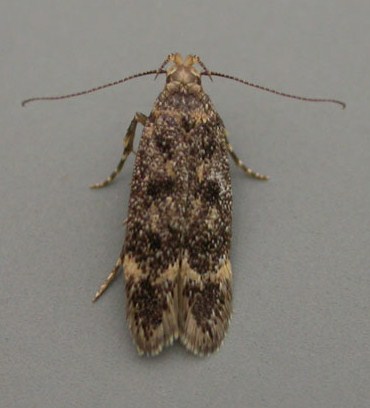
Provisional map
Foodplant and Larval Feeding Signs
Syntrichia ruralis (great hairy screw-moss) - Heckford and Sterling 2002, see plant distribution map.
On roofs in a dense whitish silken tube beneath the surface of the moss. The tube is open at both ends with green frass ejected at the lower end deep in the moss tussock. The upper end is sometimes visible on the surface of the moss where it is more flimsy and incorporates chewed moss fragments. Tortula muralis (wall screw-moss) has been given as a foodplant by Bradford, E. S., 1988, revised by P. A. Sokoloff, in Emmet, A. M., A field Guide to the smaller British Lepidoptera (edn. 2).
Also bred from a larva found during the winter on a moss covered hazel (Corylus avellana) log (E G & M H Smith).
Finding the Moth
Larva: feeds in mosses on walls and buildings.
Adult: comes readily to light and resting during the day amongst thatch or old farm buildings.
Similar Species
British specimens are very similar to Bryotropha dryadella.
In western Europe, on occasions when the two species can be directly and closely examined together, B. basaltinella is slightly more vivid with more contrasting markings and a slightly speckled appearance, whereas B. dryadella has a smooth, almost glossy forewing. These contrasts have so far not been obvious in any British specimens.
The most useful character appears to be that the costal and tornal patches on the forewing in B. dryadella never point outwards. When these are fused to form a fascia it is straight or slightly inwards-bent in B. dryadella and slightly outwards-bent (rarely straight) in B. basaltinella. As these differences can be minute and difficult to assess in all but the freshest of specimens it is nearly always necessary to dissect. The female genitalia are readily separable but the differences are smaller and can be less clear in the males.
The presence of the first discal spot above the second plical spot only otherwise occurs in B. dryadella and B. domestica.
Single brooded in an extended flight period from May to early September. The limited number of records from northern England suggest it flies in July and August at these latitudes.
Earliest: 16th May 2006 (VC31)
Latest: 24th September 1996 (VC8)

